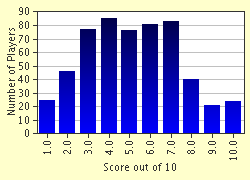Quiz Answer Key and Fun Facts
1. First of all, who named a single indivisible particle of matter an atom?
2. Who was a Greek that severely criticized the theory of atoms in continuous motion and proposed the four-element theory of matter?
3. Which of the following is not part of John Dalton's theory about atoms in 1803?
4. What did J.J. Thomson use in order to measure the mass of the atom and its electric charge in 1897?
5. In J.J. Thomson's 1897 model the electrons were located inside the nucleus (although it wasn't yet called a nucleus.)
6. What type of particles did Ernest Rutherford use in his 1911 experiment with gold foil?
7. In 1932, what did James Chadwick theorize that an atom must contain?
8. Who developed the concept of atomic number?
9. Who is credited with developing the idea of an isotope?
10. Which important scientist created the theory that electrons are located within a fixed distance from the nucleus on a certain energy level?
Source: Author
Lanire
This quiz was reviewed by FunTrivia editor
crisw before going online.
Any errors found in FunTrivia content are routinely corrected through our feedback system.


